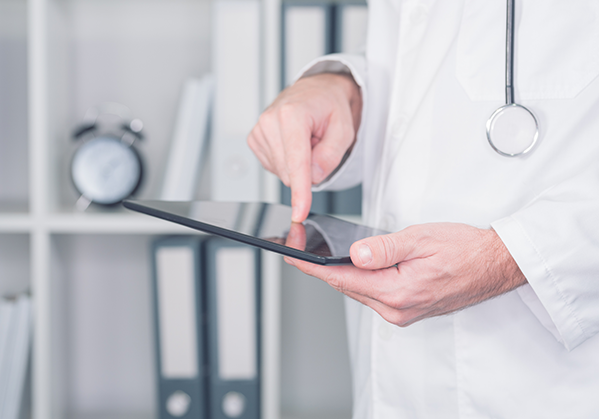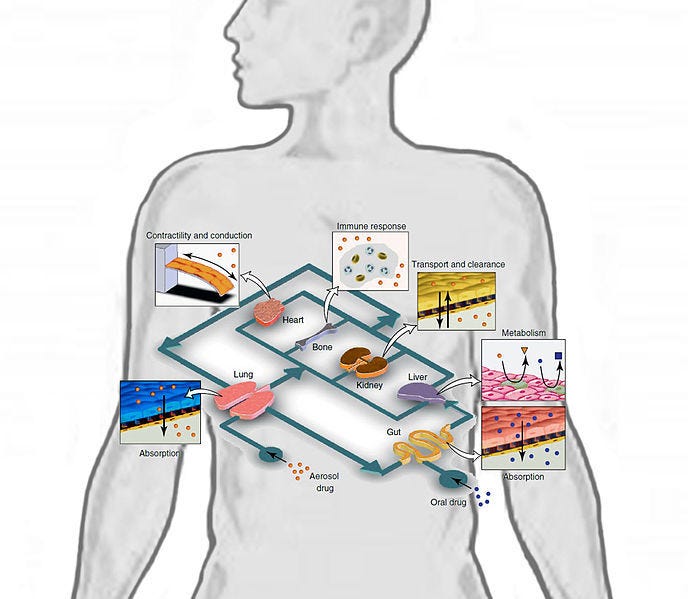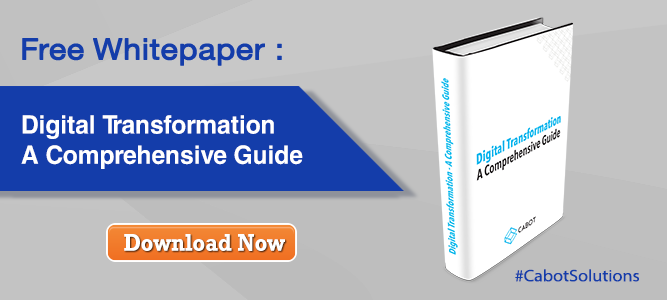Latest news about Bitcoin and all cryptocurrencies. Your daily crypto news habit.

Some people say that it is the quality of life and not its quantity that matters. Perhaps it is true because healthcare professionals focus on giving timely and accurate care to their patients. And relying on technology is the only way do it quickly. Technology can save lives — it has been proved so, time and again. Luckily the scope of what technology can do to save lives is increasing at a considerably rate.
We have attained a position where Digital Transformation is taking place rapidly in the healthcare industry. The focus is to provide exemplary patient experience, and the pharmaceutical companies and clinical care centers have made drastic changes through technological innovation and communication.
Now, healthcare and Digital Transformation (DT) go hand in hand, and patient care has been elevated to levels that were deemed impossible until some time ago. As per the recordings made in the World Health Statistics 2015 by the World Health organization, “A child born in 2013, has a life expectancy that’s seven years more than a child born 25 years earlier”. So imagine how much technology has advanced, it is a footprint left by digital transformation.
The milestones achieved by healthcare have been remarkable. If you turn back to a day from a decade ago, you will see that EMR or Electronic Medical Records were making a huge impact then. Now EMRs have become so ordinary that people don’t think twice about it. Then came telemedicine, IoT, wearables, robots — you name it, the present health care system has it.
Diseases affect the quality of life, and millions and millions of people are afflicted with all sorts of diseases globally. The changes technology has rendered in the healthcare system has improved the patients’ health and their quality of life, but it has also affected the global economy in a positive manner.
Each outbreak of illness cripples the economy. Governments will have a hard time reverting from them. According to the World Economic Forum, just five non-communicable diseases could cost the global economy $47 trillion by 2030. But with technological notifications and alerts, it is possible to identify and thwart an outbreak, and save millions of lives in the process.
What Digital Transformation Means for the Healthcare Industry
Digital Transformation is a trend that can be materialized only when the organizations can rethink business processes. In the simplest terms, DT is all about using various forms of digital technologies so it helps the customer (in this case the patient) lead a better life. The need of the patient becomes the focal point of the business. So you have to put their needs at the center, and come out with different ways in which you can make their lives better.
The idea is to make the patient become active stakeholders in their own health plan. Hence they are alert to the changes in their own health, monitor vital signs, are aware of what they should do in order to lead quality life and learn to take preventive actions against chronic illnesses. In fact, it allows the patient to become a responsible individual in the matters of their own health. And this is done through patient engagement in latest technologies. Telemedicine is a perfect example of this trend.
There is a hitch, however. Unfortunately, the idea of using technology to provide better care to patients renders several healthcare organizations to think that it is an impossible idea. They feel that it is something that will take ages to catch up. Tight budgets and limited resources also deter them from making maximum use of technology.
Healthcare organizations might be intimidated by the huge amounts of data they’ll have to deal with, as the data that flows through their systems is largely unstructured and unmanaged. However, several organizations have come forward and attempted to maneuver and innovate by using the most latest technologies and methodologies to sift through this data.
The very idea of sifting through hordes of data can be intimidating, but it can be possible when you focus on the initiatives that help minimize the efforts and costs, but brings out real results that you can use. Hence, it is important for the organizations to bring out versatile devices that save time, reduce printing, and at the same time streamline processes that ease out the day-to-day operations in healthcare centers; examples would be — overseeing and chronicling patient records, facilitating patients’ culmination of structures, etc.
Ways Digital Transformation would Revolutionize the HealthCare Industry
DT revolutionizes healthcare in such strong ways that it touches everything, right from patient registration to smart diagnosis, even in the field of coming up with self-care tools. The entire healthcare industry has transformed and metamorphosed into something magical; value-based care and positive outcomes have turned out to be the bedrocks in the next-gen healthcare. Patients have become active participants in their own health activities; they are no longer passive individuals, but play a full role by demanding involvement through knowledge sharing and responsibility.
Here are 6 ways in which it can revolutionize the industry:
1. Genomics
The study of genomic research has come a long way, and this wave started with discovery of DNA more than a century ago. The advances in technology and computers have helped in sequencing genomes faster and in a cost effective manner. This has helped scientists to understand a person’s genetic profile minutely and thereby administer treatments that could lead to better cures.
Doctors, clinicians and specialists have started using genomic sequencing to reach a better diagnosis and treat their patients much more accurately. Increase in technology and computing power has made it easier for scientists to experience the true capability of human DNA; paving the way for complete and entirely personalized form of testing and treatment. As the treatment provided is personalized, this could really cover a huge range of diseases and provide enhanced treatments to patients.
Use case:
Many companies and universities researched on genomes and genetics. One company worth mentioning here would be the Hudson Alpha, a biotechnology institute that brought an impressive array for lifesaving discoveries leading to the diagnosis and treatment of a diseases.
As research could be data-intensive, the company had to think about how they are going to process all the data. More than 6 petabytes of data had to be managed, stored and analyzed in a single year. They seriously had to rethink on the way they were implementing IT in their organization if they wanted to look after their research goals.
Hudson Alpha’s first step in the digital transformation was taken when they deployed private cloud for all their research projects. This became their IT foundation, but they still needed something more powerful, flexible and scalable to accommodate their ever-growing research need. Eventually they bagged dramatic results with using the right kind of infrastructure — combination of hyperconverged and composable infrastructure. This led to a number of advantages including (1) increased storage capacity, (2) remarkable cost reduction (3) reduced reprovisioning time from four days to a couple of hours.
The next step in digital transformation happened when they began to embrace public clouds. The initial apprehensions about privacy, regulations and security were soon met with. This was a boon because the company had many government grants to conduct researches, and they were able to try new treatment theories and create ideas right in the public cloud, without taking the resources away from the private cloud.
Eventually, the company was ready to take the next step — hybrid IT. Hudson Alpha is working with HP to make maximum use of public cloud, private cloud and on-premises IT separately and by moving applications from one model to another.
2. Big Data Used in Medicine
Healthcare industry is one of the fields where you can use big data to its maximum potential. It can rival trends that were not possible in the past, so you can say Big Data is all about delivering Big Insights. Big data analysis has evolved to be a major boon, both for managing the health of the patient and for the business angle of the healthcare organizations. DNA analysis tests and data collected from wearable medical equipment have made a detailed and comparative study of the patient, learn about their lifestyles, and that of similar patients to come up with treatment strategies.
Big data plays heavily in solving the limitations that the healthcare industry faces. The medical and pharmaceutical field can gain a lot when they understand the biology of diseases. It is possible to actually do this with the help of Big Data. Because Big Data can collect all the data and information on what constitutes a disease — right from DNA, proteins, and metabolites to organs, organisms, cells, tissues, and ecosystems. And by solving the limitations, big data can help build better health profiles and predictive models around patients to reach better diagnosis and treat diseases.
Use Case:
It is important to consider the factors in which the number of doctors and patients grow in a center. Let’s take the case of Westmed Medical Group in Westchester County in New York . The number of physicians and patients grew from 16 to 250 over the years (they started in 1996), and of course, the number of patients also steadily increased, to 250,000 patients, with an annual revenue of $285 million. When a practice grows, it is imperative to have some sort of method to analyze thousands of processes and workflows, streamline them, reduce unnecessary testing, improve patient satisfaction and so on. Big data helped the company do all these and brought better patient outcomes.
3. Organs on Chips
Doctors and patients keep their fingers crossed when they try new treatments, because you get the results only after applying them. How about having electronic sensors to measure different kinds of treatment possibilities at the cellular level. The best possible treatment would then be chosen and then administered to the patient. This kind of trend was made possible by making advancements in DNA sequencing and through in-depth stem cell research.
Conceptual Schematic of a Human-on-a-chip
 Image Credit: Timothy.ruban — Own work, CC BY-SA 3.0
Image Credit: Timothy.ruban — Own work, CC BY-SA 3.0
To administer treatments by understanding the diseases at cellular level can be possible with digital transformation. This futuristic treatment is done through tiny technology in the form of chips to ensure the patients gets only safe drugs. The patient no longer has to be the testing ground for experimental drugs anymore. And this is an incredible achievement, considering the fact that the human body is the most complex one of nature’s creations.
Use case:
Wyss Institute, a Harvard unit has made incredible advances in this field, by working on biologically inspired engineering projects. They created tiny versions of chips that were so tiny that they looked like USB drives. They created a number of chips in this manner for example, lungs that mimics human breathing and works exactly like the human lung.
Similarly, they made chips of other organs like kidney, heart, gut, bone marrow and so on. The organs on the chip device can provide the cells with nutrients and oxygen, just as the cells in the human body are sustained through blood. These cells grow and respond exactly like the real cells in the human organ, and definitely much better than the cells grown in petri dishes.
The Wyss Institute tested the chips successfully and scientists would no longer have to do animal testing. Now drugs can be safely tested before they are tried on the patient. And scientists no longer have to worry about the ethical concerns (that usually accompany animal testing) as well.
4. Genetic Engineering
Genetic engineering and the use of genetically modified viruses can fight diseases, and this trend is becoming increasingly common. For example, genetically modified mosquitoes are being created and deployed to fight against diseases like Zika virus and malaria. However, using genetic engineering using human DNA is highly controversial, and there are many boundaries to consider while doing the testing.
Use Case:
The Monash University in Australia has developed a technology to fight dengue with the help of Wolbachia-infected A. aegypti mosquitoes. The idea is to make the mosquitoes fight the viruses that they themselves spread. Aedes aegypti mosquitoes are deployed to carry Wolbachia, a naturally occurring bacteria. This way the mosquitoes will transmit the viruses when the males mate with the female, and infect the offspring. The first place where this was tested is Gordonvale, south of Cairns in North Queensland. Wolbachia-implanted Aedes aegypti mosquitoes were released to mate with wild mosquitoes there.
Professor Scott O’Neill was the scientist behind this innovative trend. And the good news is that Queensland hasn’t seen an occurrence of dengue for the past 7 years (the period of time in which Wolbachia has been deployed).
This new approach where insects are used to control diseases are known as biological vectors. This trend has also been used to curb the emergence of Zika, a frightening disease that damages the brains in babies. New vector control experiments are still underway.
5. Telemedicine
It could be a dream come true if doctors are able to treat patients living in the remote villages. And it could be a dream come true for patients to get the best possible treatment at a fraction of a cost. Now the world’s poorest people can also get the same kind of medical treatment as a rich person would. This was possible through telemedicine. The success of Telemedicine lies in DT, and how the internet has been able to penetrate the remotest of villages. According to data from International Telecommunications Union, an agency of the United Nations, “3.2 billion people use the Internet globally, and out of this, about 2 billion are from developing countries”. In 2000 there were 738 million mobile subscriptions worldwide. At present it stands at 7 billion.
There are web applications that people can download to monitor their health, and based on the alerts and notifications from these apps, they can get better health care and on time too. And that’s not all. These apps can help people reduce hospital visits, a great thing because doctors can focus on people requiring hospitalization. The medical industry has gone through tremendous changes that includes accurate and timely healthcare for all.
Use Case:
Grand Manor Nursing and Rehabilitation Center in Bronx, New York is a perfect example of a healthcare center that practices telemedicine to provide quality care to its patients. The hospital also monitors the health of a resident to ensure timely treatment is provided when the patient’s health goes downhill. A pilot program, The Telemedicine Pilot Program Implementation does this and nurses and doctors are provided with adequate information regarding the health and lifestyle of the patient.
6. 3D Bioprinting
An X-ray doesn’t really give you the real picture. Certain areas can be distorted, while certain areas can be highlighted unnecessary. This was because doctors were looking at 2D images. Most of the surgeries conducted in the past were based on assumptions and guesswork. But with virtual reality, it is possible to understand the organs and their positioning in alarming clarity and in three-dimensional terms. This is known as 3D bioprinting.
3D Bioprinting Process
 Image Credit: Nature Biotechnology
Image Credit: Nature Biotechnology
It is a process involving the three-dimensional printing of cells and tissue and organs by layering (3D gel, which is a dissolvable hydrogel) cells, biologic scaffolds, and growth factors accurately. This allows the doctors to look into the patient’s body before actually doing the surgery so they would be better prepared to face the challenges that are likely to arise during the actual procedure. Doctors can confront the unknown even before they make the first incision.
3D bioprinting can play a crucial role in personalized medicine and there are different methods used in this technique — acoustic bioprinting, inkjet-based bioprinting, extrusion-based bioprinting, and laser-based bioprinting.
Use Case:
University of Minnesota was in the news last year for their successful separation of twin sisters who were conjoined at birth. One of the twins relied on the other one’s heart to filter out impurities. They were attached from the lower part of their chest to their belly buttons. The doctor team studied the babies through 3D bioprinting and virtual reality and practiced the procedure 8 times before doing it for real. They were successfully separated.
The doctors wore Google like virtual reality glasses and explored three-dimensional model of the twin’s hearts and explored the infants’ anatomy in minor detail. They blew up the 3D image of the infants’ anatomy before deciding on the right way to do the procedure.
Conclusion
Healthcare companies from around the world are turning digital technologies into strategic assets. A few of the ambitious ones are bridging the between digital IT and legacy by indulging in complex systems transformations. They are performing their own experiments to make the best of data and boost the speed of R&D. At the rate digital transformation is moving now, we can rightly assume that the patient will be sitting in the driver’s seat soon enough, and they are likely to receive the best treatment at reduced costs, thereby increasing life expectancy too.
Interested in implementing digital transformation in your healthcare organization? Let us assist you!
Originally published at Cabot Solutions on October 9, 2018.
Digital Transformation and its Significance in Healthcare was originally published in Hacker Noon on Medium, where people are continuing the conversation by highlighting and responding to this story.
Disclaimer
The views and opinions expressed in this article are solely those of the authors and do not reflect the views of Bitcoin Insider. Every investment and trading move involves risk - this is especially true for cryptocurrencies given their volatility. We strongly advise our readers to conduct their own research when making a decision.

